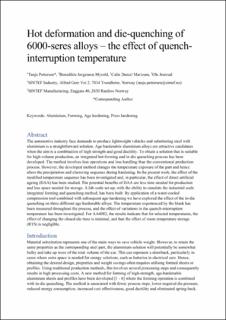| dc.contributor.author | Pettersen, Tanja | |
| dc.contributor.author | Myrold, Benedikte Jørgensen | |
| dc.contributor.author | Marioara, Calin Daniel | |
| dc.contributor.author | Jensrud, Ola | |
| dc.date.accessioned | 2022-10-20T09:29:40Z | |
| dc.date.available | 2022-10-20T09:29:40Z | |
| dc.date.created | 2021-01-28T14:19:39Z | |
| dc.date.issued | 2020 | |
| dc.identifier.citation | Light Metals, 2020, 412–418 | en_US |
| dc.identifier.isbn | 978-3-030-36407-6 | |
| dc.identifier.uri | https://hdl.handle.net/11250/3027254 | |
| dc.description.abstract | The automotive industry face demands to produce lightweight vehicles and substituting steel with aluminium is a straightforward solution. Age hardenable aluminium alloys are attractive candidates when the aim is a combination of high strength and good ductility. To obtain a solution that is suitable for high-volume production, an integrated hot forming and in-die quenching process has been developed. The method involves less operations and less handling than the conventional production process. However, the developed method changes the temperature exposure of the part and hence alters the precipitation and clustering sequence during hardening. In the present work, the effect of the modified temperature sequence has been investigated and, in particular, the effect of direct artificial ageing (DAA) has been studied. The potential benefits of DAA are less time needed for production and less space needed for storage. A lab-scale set-up, with the ability to simulate the industrial scale integrated forming and quenching method, has been built. By application of a water-cooled compression tool combined with subsequent age-hardening we have explored the effect of the in-die quenching on three different age hardenable alloys. The temperature experienced by the blank has been measured throughout the process, and the effect of variations in the quench-interruption temperature has been investigated. For AA6082, the results indicate that for selected temperatures, the effect of changing the closed-die time is minimal, and that the effect of room temperature storage (RTS) is negligible. | en_US |
| dc.language.iso | eng | en_US |
| dc.publisher | Springer | en_US |
| dc.relation.ispartof | Light Metals 2020 | |
| dc.relation.ispartofseries | The Minerals, Metals & Materials Series;2367-1696 | |
| dc.subject | Press hardening | en_US |
| dc.subject | Age hardening | en_US |
| dc.subject | Forming | en_US |
| dc.subject | Aluminium | en_US |
| dc.title | Hot Deformation and Die-Quenching of 6000-Series Alloys—The Effect of Quench-Interruption Temperature | en_US |
| dc.type | Chapter | en_US |
| dc.type | Peer reviewed | en_US |
| dc.description.version | acceptedVersion | en_US |
| dc.rights.holder | This is the author accepted manuscript of the article. Publised VoR is avaliable at 10.1007/978-3-030-36408-3_58. | en_US |
| dc.source.pagenumber | 412-418 | en_US |
| dc.identifier.doi | 10.1007/978-3-030-36408-3_58 | |
| dc.identifier.cristin | 1881333 | |
| dc.relation.project | Norges forskningsråd: 295816 | en_US |
| cristin.ispublished | true | |
| cristin.fulltext | postprint | |
| cristin.qualitycode | 1 | |
